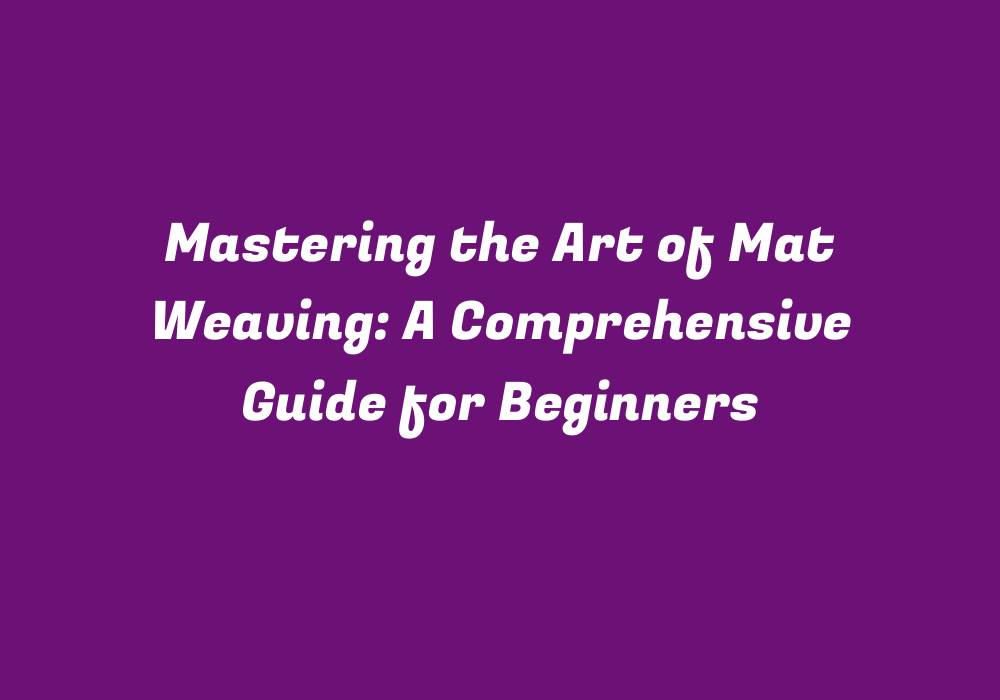Mastering the Art of Mat Weaving: A Comprehensive Guide for Beginners
Introduction to Mat Weaving
Mat weaving is an art that involves creating beautiful and functional mats from various materials like wood, fibers, or natural elements. It has been practiced since ancient times across different cultures for its aesthetic appeal and practical purposes. As a beginner, understanding the fundamental concepts and techniques of mat weaving will help you become proficient in this craft. In this guide, we will cover the essential tools needed, materials for weaving, different types of weaves, and tips to improve your skills.
Essential Tools for Mat Weaving
Before diving into mat weaving, having the right tools is crucial. The following items are required for successful results:
1. Loom or frame – A loom or frame serves as a structure that holds the materials in place while weaving. There are different types of looms available, such as wooden frames with adjustable warps and simple peg looms made from PVC pipes. Choose the one that suits your project and level of expertise.
2. Needle – A needle is used to insert and remove weft threads through the weave structure. You can use a regular sewing needle or a crochet hook for easy manipulation.
3. Yarn – Mat weaving often uses different types of yarns like cotton, linen, wool, or synthetic materials. Choose yarns that are soft and have good quality to create durable mats. It is essential to consider the size of the yarn according to your project’s requirements.
4. Scissors – A pair of scissors will come in handy for cutting threads, trims, and materials as required throughout the weaving process. Keep them sharp for precise cuts.
5. Measuring tape or ruler – A measuring tool is necessary to determine the appropriate lengths for your weave pattern. It’s also helpful when setting up warps on your loom or frame.
Materials for Mat Weaving
In addition to yarn, several other materials are commonly used in mat weaving:
1. Foundation – A foundation is a base material onto which the weft threads are laid. It can be made from various materials like wood strips, woven cane, or even plastic strips. The choice of foundation will depend on the desired aesthetic and practicality of the final product.
2. Binding thread – This type of thread is used to secure and finish the edges of your mat weave. It usually has a different color and texture than the main yarn to create a striking visual contrast.
3. Embellishments – To make your mat more unique and decorative, incorporate various embellishments like beads, sequins, or ribbons. These elements can be integrated into your weave pattern for an added touch of creativity.
Types of Mat Weaving Techniques
Mat weaving can be categorized into three primary techniques: over-one, under-two, and twill weaves. Each one offers a distinct look and feel to your mat.
1. Over-one weave – This technique is also known as plain or basketry weave. It creates a uniform, solid-looking surface with the weft threads going over each warp thread in alternating patterns. This style is commonly used for functional mats like table runners and placemats.
2. Under-two weave – In this technique, the weft threads pass under two adjacent warp threads at a time, creating a slightly raised pattern on the mat surface. It results in an elegant look that resembles a woven fabric. The under-two weave is often utilized for more decorative mats such as wall hangings and artwork pieces.
3. Twill weave – This technique creates a distinctive diamond or chevron pattern on the surface of your mat. In this weaving style, the weft threads cross the warp threads at an angle rather than following a straight path. Twill weaves are often employed for creating unique, artistic mats that can double as decorative accents in any room.
Tips for Improving Your Mat Weaving Skills
1. Practice patience – Mastering mat weaving requires time and dedication to perfect your techniques. Be patient with yourself during the learning process, and soon you’ll notice improvements in both quality and speed.
2. Experiment with materials – Try incorporating different yarns, fibers, or natural elements into your weaving projects for a variety of textures, patterns, and styles. The possibilities are endless, and experimenting can lead to new discoveries in the world of mat weaving.
3. Use inspiration from nature – Pay attention to the beauty found in nature’s patterns and designs. Incorporate these inspirations into your weave projects for a unique blend of natural aesthetics and artistic expression.
4. Seek out tutorials and guidance – There are many online resources, books, and workshops available for learning mat weaving techniques. Take advantage of these valuable tools to enhance your understanding and skills in this craft.
5. Share your creations with others – Engage in social media platforms like Instagram or Facebook groups where you can share your progress, ask questions, and gain insights from other weavers. The community support will help motivate you on your mat weaving journey.
Conclusion
Mat weaving is a rewarding and enriching experience that allows you to create beautiful, functional art pieces with various materials. By mastering the essential techniques and exploring different styles of weave patterns, you can express your creativity and improve your skills as an artist. So go ahead and start weaving – the possibilities are endless in this fascinating art form!
